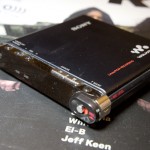First released by Sony in 1992, minidisc was the company’s second attempt to create a recordable digital audio device for consumers, after the release of digital audio tape (DAT) was complicated in the 1980s by the recording industry. Although Sony first boneheadedly marketed MD as an ultra-portable CD replacement, eventually the digital recording capacity of the medium won over.
One place where MD found a foothold was in radio. It’s hard to remember a time when you couldn’t listen to an MP3 online or load up thousands of songs on a player the size of a wristwatch. But back in the mid-90s digital computer-based audio was still a tricky and expensive proposition, and the recordable CD-R had yet to be released. A decent PC or Mac-based digital audio workstation easily could set a station back five to ten grand. Storage costs easily went up from there, since a gigabyte hard drive storing a bit less than two hours of audio cost hundreds of dollars.
By comparison, minidisc offered stations an inexpensive way to digitally record programs from satellite, prerecorded shows, on-air spots or airchecks. A pro-level deck could be had for just around $1000 and the reusable discs cost just a couple of bucks. Operating much like a tape deck, very little training was required for air staff to begin using them.
Portable minidisc recorders were also smaller than most other portable recorders of the time, while offering better sound quality and durability than the ubiquitous cassette recorder. By the late 1990s most major radio networks and producers, including NPR and the BBC, were using minidisc recorders for field reporting.
An especially useful feature of minidisc was the ability to edit right on the disc. Although the process seems slow in comparison to editing a waveform on a computer, it was still a lot easier and less error-prone than editing reel-to-reel tape with a razor blade, as many stations were still doing in the early 90s. I edited a lot of minidisc in my day, and while I wouldn’t have wanted to edit together a complex half-hour feature, it was very simple to trim the heads or tails off a track or move tracks around. At community radio WEFT we used minidisc to record our daily syndicated news programs from satellite and relied upon the editing function to cut some programs into sections for easier station breaks.
Minidisc also caught on with amateur and home recordists. Although the multi-track minidisc recorder never caught on, the technology offered an inexpensive, high quality and very portable way to record audio in the field. Many musicians relied upon minidisc to record their own live shows, or to demo tracks at home.
Even though minidisc was popular in radio, studios and amongst amateur recordists, Sony always hoped it would be a hit consumer technology. And, frankly, with some 22 million recorders sold by Sony worldwide in the last nineteen years we really can’t call minidisc a failure. Still compared with 297 million iPods sold, poor minidisc is a bit outclassed.
Sony has pretty much already ended manufacture of all but one minidisc recorder model by now. I don’t think there’s been a pro deck in their lineup for a few years. However, pro audio manufacturer TASCAM actually introduced a brand new CD/MD combo deck just this past April. The MD/CD1mkIII is aimed squarely at radio stations and recording studios that either still have minidisc as part of their workflow or have an archive of discs they still want to play.There are at least four working minidisc recorders in my house, and I must own several hundred discs. About half of my discs have audio that I recorded myself, containing airchecks of my radio shows, segments I recorded for air, live shows or other field recordings. The other half contains music, many of them minidisc mix tapes. You see, a minidisc recorder functioned as my main portable music player for a decade until about 2007 when I got my first reliable MP3 player. I even used to listen to podcasts downloaded to minidisc.
Yes, Sony may be ending manufacture of their minidisc recorders, but minidisc is not dead. Sure, a large percentage of those 22 million minidisc players are probably lost in the back of closets and drawers. But a lot are still in use today by people who don’t see a need to ditch a technology that works, or who have a cherished archive of music and programs recorded on MD.
I’m always a little annoyed when the tech press/twitter/blogosphere jumps on these announcements declaring a technology to be obsolete and dead. I’m not just driven by nostalgia. Rather, in some regards it’s wasteful to ditch a functioning bit of technology only because it’s not popular anymore. Just because Sony soon won’t be making recorders doesn’t mean that the deck in your studio or on your shelf is instantaneously useless.
I agree that by and large portable digital audio recorders that use memory cards and computer editing are actually easier to use than minidisc. But anyone who has lost multiple hours of stuff to a corrupted SD card, or thousands of songs to a dead hard drive might see the value in a study little disc that only hold a few hours at best, and is built to survive a lot of abuse. You lose a hard drive and your whole music collection might be gone. You misplace one minidisc and you’ve lost no more than a couple hours of audio.
¡Viva la minidisc!




